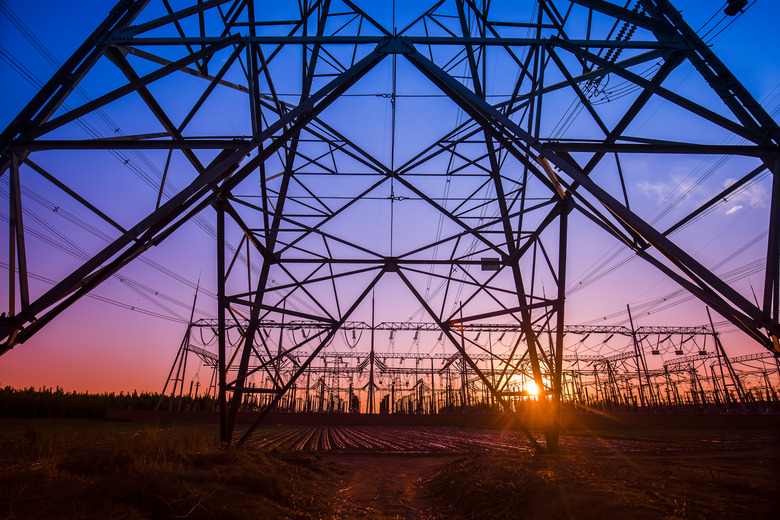Electric Energy Advantages & Disadvantages
Before you lament the price of electricity, imagine life without it. Candles and lanterns would light your way, you'd keep food cold using ice, and every electronic device you ever plugged into a wall socket would no longer work. However, with the immense benefits that electrical power provides come some disadvantages besides cost.
TL;DR (Too Long; Didn't Read)
Electric energy is central to our quality of life, and virtually everything we do depends on it one way or another. On the downside, power plants can create pollution — and then there's that pesky electricity bill.
The Joy of Electrical Current
The Joy of Electrical Current
Hospitals, police, armies and governments rely on electrical power to assist, protect, govern and communicate. Electrical power is so important that the White House noted in a 2012 blog post, "protecting the electric system from cyber threats and ensuring its resilience are vital to our national security and economic well-being." The nation's electric grid consists of 450,000 miles of transmission lines connecting transformers, power plants and consumers.
AC vs. DC: Power Transmission Becomes Economical
AC vs. DC: Power Transmission Becomes Economical
In 1882, the country's first power plant relied on direct current, or DC, in which electricity flows in one direction. In the late 1800s, Nikola Tesla and George Westinghouse helped pioneer alternating current, or AC, technology. Moving in two directions, AC makes it possible for power plants to transmit power long distances at costs cheaper than if they were using DC. Today's power plants supply AC electricity to homes and businesses around the world.
Advantage: Multiple Electricity Sources
Advantage: Multiple Electricity Sources
According to the U.S. Energy Information Administration, fossil fuels such as natural gas, coal and petroleum produced 67 percent of the nation's electricity in 2013. In addition to obtaining electricity from nuclear power plants, some people can get hydropower, or electricity that comes when you harness the energy of falling or running water. If you live in a windy area or one that receives lots of sun, wind or solar power might be an attractive energy option. It's also possible to generate electricity by using heat from below Earth's surface to produce steam that turns turbines. People also generate electricity from biomass, which is material from sources such as wood, fuel crops and agricultural wastes.
Disadvantage: Unwanted Side Effects
Disadvantage: Unwanted Side Effects
Power plants that burn biomass release sulfur dioxide and nitrogen oxides, two undesirable pollutants, into the air. Power plants that burn fossil fuel pump carbon dioxide into the atmosphere. Carbon dioxide is a greenhouse gas that causes Earth's temperature to rise. Nuclear power plants must find ways to dispose of radioactive waste safely. Building dams to create hydropower plants can affect wildlife and natural resources adversely.
Disadvantage: Oops, the Lights Went Out
Disadvantage: Oops, the Lights Went Out
You may have lived without electricity when storms or accidents disabled power lines or transformers or experienced brownouts during which you received reduced electricity. These incidents may occur when power demands exceed a utility company's ability to provide it.
Paying the Costs
Paying the Costs
Unless you generate your own power using a source such as solar, you probably pay a monthly utility bill that varies between regions. If you get your electricity from your own solar or wind source, you have no monthly fees. In fact, it's sometimes possible for you to sell excess power you generate using these methods to utility companies. Although you must pay for solar equipment and installation, prices continue to drop as the market matures.
References
- Energy.gov: Top 9 Things You Didn't Know About America's Power Grid
- The White House Blog: Protecting the Nation's Electric Grid from Cyber Threats
- Universe Today: Who Discovered Electricity?
- History: Nikola Tesla
- U.S. Energy Information Administration: What Is U.S. Electricity Generation By Energy Source?
- U.S. Environmental Protection Agency
- National Geographic: Hydropower Going With the Flow
- Mass.gov: Energy and Environmental Affairs
Cite This Article
MLA
Lee, Kevin. "Electric Energy Advantages & Disadvantages" sciencing.com, https://www.sciencing.com/electric-energy-advantages-disadvantages-6008663/. 25 April 2018.
APA
Lee, Kevin. (2018, April 25). Electric Energy Advantages & Disadvantages. sciencing.com. Retrieved from https://www.sciencing.com/electric-energy-advantages-disadvantages-6008663/
Chicago
Lee, Kevin. Electric Energy Advantages & Disadvantages last modified March 24, 2022. https://www.sciencing.com/electric-energy-advantages-disadvantages-6008663/
